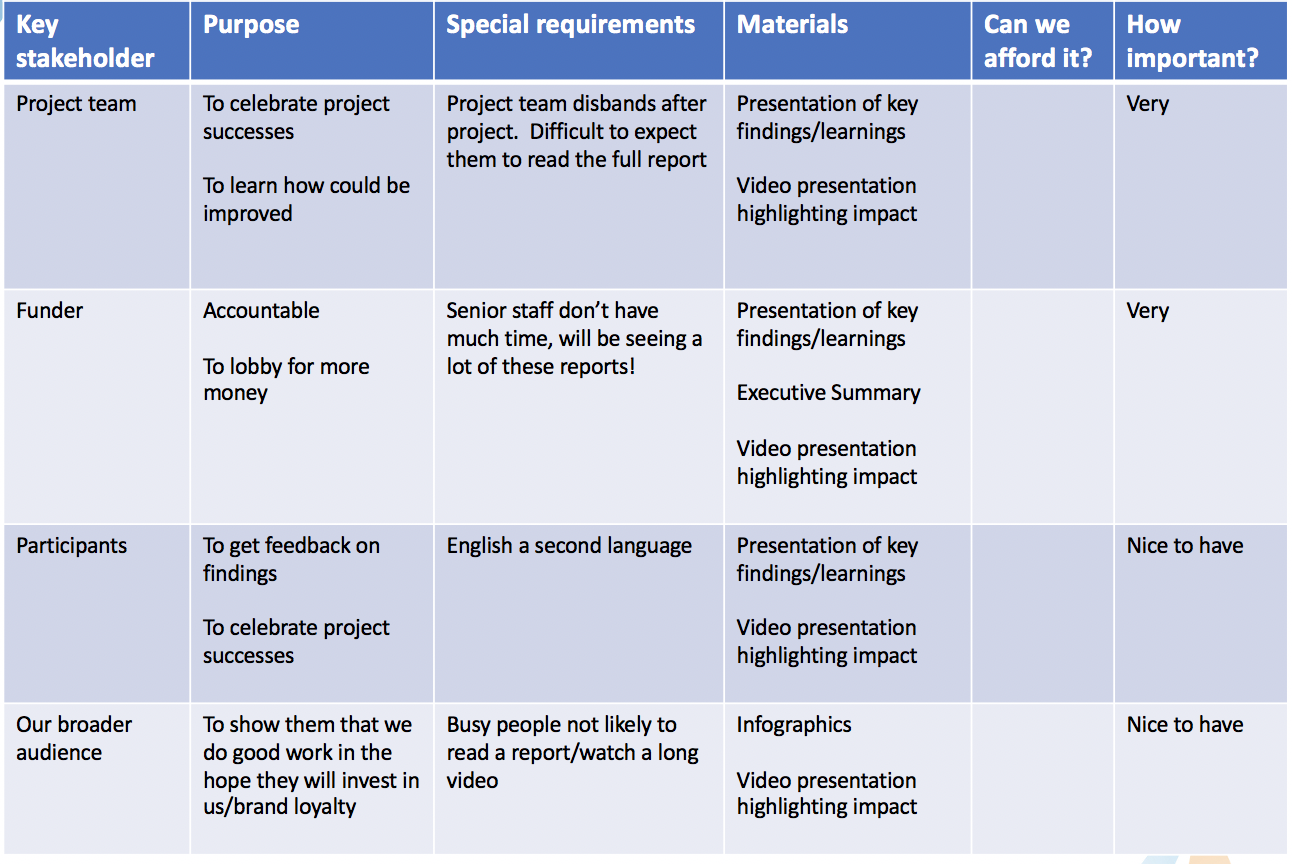Communicating evaluation findings
You’ve collected all your data, you’ve analysed it and you’ve written the report. Job done?
Well that depends.
There are few more questions to ask yourself? For example:
Are my key stakeholders likely to actually read my report?
If my results are persuasive, will a report alone do the trick in getting the word out?
Usually, in my experience, the answer is, ‘probably not.’
That’s why it is really important, from the very beginning (if possible), to think about how you’d like to communicate your results.
Why it is important
A lot of time and effort goes into conducting evaluations. Thinking through how you will communicate your results will help you get the most ‘bang for buck’ out of that effort. For example:
You may have useful lessons to share with the project team and/or the sector
You may have some compelling or persuasive statistics or stories that could be used to support things like:
brand building
fundraising
influencing (policy-makers, senior management etc.)
But don’t confuse evaluation with advocacy. Evaluation results can be used to support advocacy but it mustn’t drive this work (more on that later).
What kind of communication materials are there?
Good communication materials pull key information from your report and present it in an engaging, accurate and easy to understand manner.
Common materials include:
Executive or Summary findings
Fact sheets
Infographics
Video presentations
Content for web or social media campaigns
Conference presentations
Articles, press releases etc.
Ethical considerations in communicating results
When using findings out of the context of the report it is really important to be ethical. All the same ethical considerations apply as when you report your results (See Tips for Writing an Evaluation Report). But it is also important to think through how they apply to the new context in which you are reporting.
There are also some other considerations you may need to think through. For example:
Don’t cherry pick only positive results
Don’t confuse advocacy with evaluation activity. For example:
You can use evaluation findings to support advocacy but it shouldn’t drive this work. You must create a safe space for people to tell you confidentially about their experience good or bad.
For example, if you want to bring your results to life with interviews that’s OK, but do it as a separate exercise to any interviews you have planned for the evaluation. Interviewees might feel pressure to tell you only stuff they think you want to hear on camera (i.e. social desirability bias).
For your inspiration…
There are many examples of great communications materials out there for your inspiration. You have probably come across many yourselves.
Here are some examples that inspire me….
Helpful tools
Here are some handy free and low cost tools I have used in the past to help with producing communications materials for evaluation results. There are lots out there. Find the ones that you like and work best for your needs.
Free/low cost graphic design software: provides great adaptable templates for reports, infographics, social media infographic templates etc.
Two I have used in the past are:
Explainer video software: provides great templates for designing video presentations
One I have used in the past is:
This video gives examples of these tools in action
How do I decide what is necessary?
Start by developing a communication strategy, sometimes known as a dissemination plan. It will help you identify the best methods to communicate your results and the resources you’ll need.
Tops tips
Don’t do everything
Prioritise the things that will resonate with your audience
Allocate budget and time to do these tasks e.g. photographer, videographer, software, graphic designer etc.
Assign responsibility
Build in time for learning design software. It is designed to be user-friendly but it is easy to get carried away!
Put your plan together asap because you may need to collect materials during your project (in addition to research data) e.g. photos, video etc.
The diagram below steps you through a dissemination plan if you are doing it for the first time.
Step 1. Identify your audience
The first step is to work out who you want to communicate your results to. This might include the following stakeholders:
The project team
Funders
Participants
Your followers
Step 2. Articulate why you want them to know about your results
Spelling out why you want each group to know about your results will help you work out what materials are going to be most suitable. Some reasons might include
Celebrating the project
Accountability requirements
Advocacy
Step 3. Identify any special requirements
The next step is to think about whether anyone has any special requirements. For example:
Are you dealing with time-poor people who won't have time to read a report?
Is English a second language for some stakeholders? Would they respond better to audio visual materials etc.?
Do any stakeholders have accessibility requirements?
Do some of you stakeholders have stakeholders of their own e.g. your Executive might need to report to the board, what kind of materials might be useful for them?
Step 4 - 5. Identify appropriate materials and resources you’ll need
Steps two and three will help you work out which are the most appropriate materials for each group i.e. the materials they will respond to and will meet their needs.
That final step is to work out which materials to prioritise and whether you can afford it.
Can I have a template?
Why yes! Here is a template that I have used in the past. It also includes a worked through example.
Evaluation results dissemination plan template





